7-25-20
August at Akiko’s: A Transformative Experience
By Diane Sippl
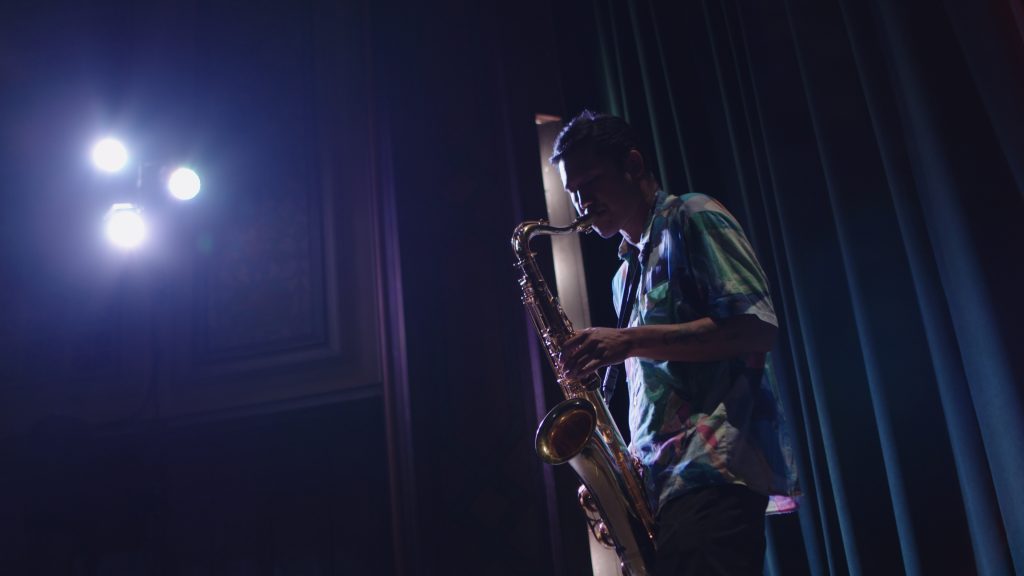
This world is but a single
dewdrop, set
Trembling upon a stem; and
yet... and yet...
Kobayashi Issa
Translated by Harold Stewart
Your father is a farmer. Your mother died before you got to know her; it is your grandmother who raises you, with all her love. Early on, you relish studying under Shimpo, the local poet. But your father has married again, and when his wife bears him a son, it seems you are beaten a hundred times a day. They call you moody, since you take to wandering in the fields. In your early teens, your grandmother dies and you feel yourself a stranger in your own home. Your father sends you to Edo to study haikai, but you work hard at menial jobs just to survive. While your poems are increasingly admired and you are appointed to teach, your modernist style does not fit with the school, and you are traveling once again, the length and breadth of Japan. When your father dies, your step-mother and her son dishonor his will and it takes you a decade to gain your inheritance. By then you are half a century old, but you take a young wife to start a family; yet your first-born dies right after birth, and two years later, your next child dies, and then your third—and a few years later, your wife. You marry again, but without success. Soon your home burns to the ground and you are driven to live in your windowless storehouse. Still, you marry again, and your wife is pregnant with a baby girl who outlives you, because you die before she is born.
Tragedy found you around every corner, yet in all your travels, you followed Buddha, trusting in the path of grace and compassion, knowing transience and reincarnation. You learned to find joy in the most ordinary moments, to show affection and kindness toward the lowliest of creatures—cats, bats, gnats, frogs, fleas, flies. Your elemental and direct language gave new life to the haiku form; your humble doubts and confessions brought consolation to all. You called yourself “Issa”—“Cup-of-Tea”—so simple, but 20,000 Japanese haikus later, you became known as “the single bubble in a cup of steeping tea.” Grandparents, scholars, and tiny children savor your poems to this day.
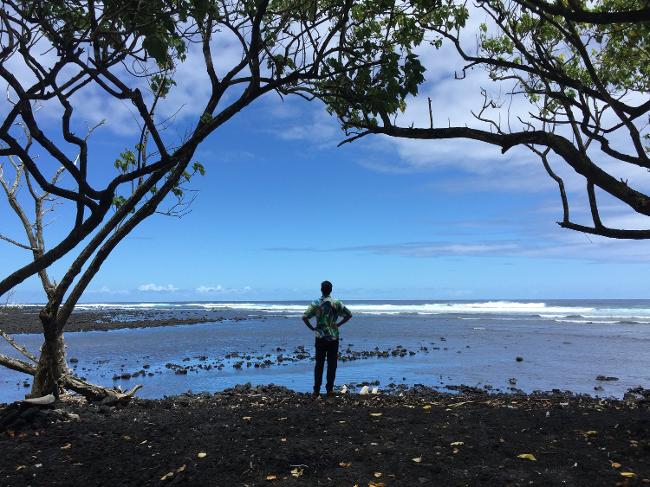
In August at Akiko’s, we meet Alex, who lands in Hawaii looking for “grandma’s” house. It’s no longer there. Developers are working on sites in Ninole; the “Big Island” is once again on the cusp of change. After asking everywhere for Marianne and Howard Migita, Alex gets a call-back from afar informing him that his grandmother has passed, and thus shortly thereafter, his grandfather, too. The caller suggests that he look up Akiko, who might give him a room to rent.
“How long do you need it for?” asks Akiko.
“I don’t know yet.”
“I see... Where did you just come from?”
He’s fine with that, so she leads him to a simple abode across the way, and when she notes his saxophone, she asks, “You are a traveling musician?” His windows open to nature — the chirping of crickets, the mating calls of coqui frogs, the breeze in the trees.“It’s a long story,” he replies.
“It’s a long story. Ah-ha...” she nods. “This is a Buddhist bed-and-breakfast. Pretty quiet. Not too much action. We do meditation here, yoga. This appeals to you?”

We’ve already heard Alex play his sax, the notes scraping and cracking as we see what he sees, feel what he feels. He plays in a modernist style, improvisational but also avant-garde, emanating his own truth in lieu of a conventional melody, even if he played a bluesy version of “Auld Laing Syne” the night he arrived, with his back to us as he gazed out at the ocean at dusk from his room at the Hotel Hanokaa Club. Wherever he drives, he carries with him a raw, percussive sound bank that fills the space with his perception. He walks a lot, past carved tombstones with Japanese inscriptions and old trees with tangled roots.
In fact, the film began with an extended sequence at Akiko’s, the camera already there inside, panning slowly through her windows, back and forth into her yard, then into her house as she lights incense, and out again as she chimes a large bell, eight times at equal intervals, to commence meditation. Beyond the bell, her “silence” gets filled with sound—wind, waves, rain. We wonder: Alex’s sax and Akiko’s bell—how will the two mesh without losing the life force of either, and perhaps even by each enhancing the other? Will we experience a journey in Zen?
It hardly feels as such when another sequence shows an older man driving a car alone in the twilight until it collides with a big tree; the headlights remain on, the horn gets jammed, and for the next ten seconds, we experience three layers of sound at once: the blaring car horn, a screeching siren, and Alex’s sax, all contributing to one grand cacophony. Yet it may well be a moment of “presence” not at all in conflict with Akiko’s solace, nor in harmony with it, for both contribute to a bigger sense of Oneness.
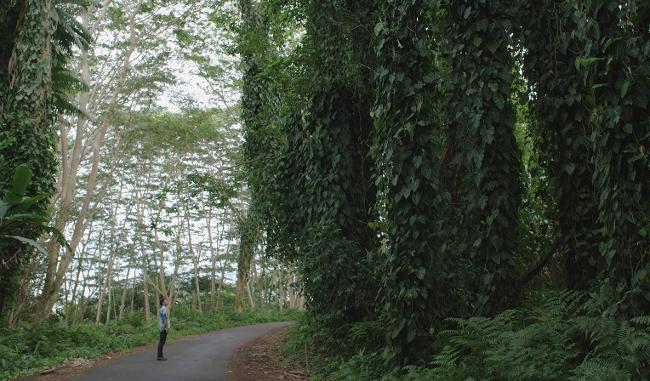
As Alex explores the atmosphere of the island, the film takes on the tone of an unspoken odyssey, a quest for home, heritage, belonging, acceptance—yet without fixing, claiming, owning. Not to “find” or to “take,” but to be. A placard on the window sill in Alex’s bathroom possibly offers the bust guidance:
As a guest leave no Trace,
No Face,
In fact leave only a
“presence,”
a feeling that for a moment
you loved a place so deeply
that both you and the place
were transformed,
and both
became more beautiful, more
natural and
inseparably
one.
One aspect of the film that generates a universality of time—or a strange sense of bonding that both includes and transcends observable time—is scenes of rituals, each with its measured and appropriate gestures and words, pace and rhythm. Such devotion is depicted not only in Akiko’s precisely repeated practice of za-zen (sitting meditation), but also in devotion to ancestors. We see the Japanese-Hawaiian community cleaning the tombstones and grounds of a small cemetery in the woods and five people holding hands in a circle over a grave as Akiko proclaims, “Cars pass to remind us life goes on. Human beings go here and there. We are here today just to honor our ancestors and our spirits. Mahalo, Mahalo, Mahalo.”
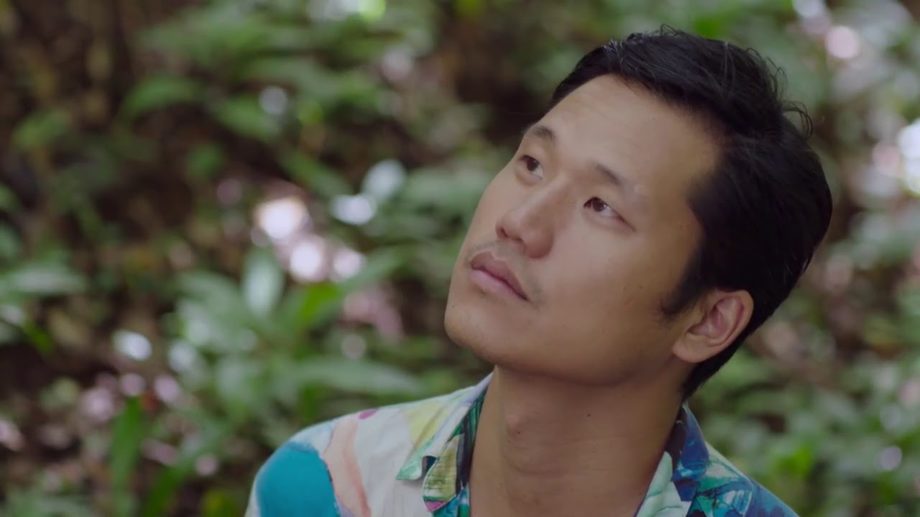
After all, it’s the annual summer Festival of Obon, and Akiko leads Alex to a performance of energetic Taiko drumming, to Bon Odori street dancing in which he participates, and to coconut milk refreshments. The town is alive with three days of festivities that integrate him with old-time residents, and he meets others individually. A woman from Okinawa plays her biwa for him, a Japanese-style lute, and teaches him how to tune it; someone else resurrects a dusty old antique saxophone that’s missing its neckpiece (so has gone silent). Alex plays tag on the grass with young Phoenix, racing, doing a “chicken walk,” and catching (as opposed to killing) flies in an insect net. The child sees him smoke under the gazebo and subjects him to an explanation as to why people do it if they know it’s bad for them. When Akiko asks Alex if he’d like to start a family, he says yes, but he doesn’t have the means; one needs to be responsible to raise children, or bad karma can come.
The camera’s long shots and wide shots often foreground the place itself—Hawaii—as a key character. Alex (well over six feet tall) is dwarfed by the palms and ferns as he walks down a road; they appear to tower over him infinitely. He is but a speck on an old footbridge as the lens frames him in a forest dense with foliage in every shade of green. It’s nearly half an hour into the film before we see a full, frontal close-up of his face, one serious, sad, filled with longing. As he sits in meditation at Kiko’s, superimpositions of road travel cover his torso—the face of an old man with a white beard and moustache with the sound of wheels and a stuck car horn, and then the image of Alex walking in the forest and encountering the full figure of a woman dancing. These traces “veil” his body, itself deep in meditative focus.
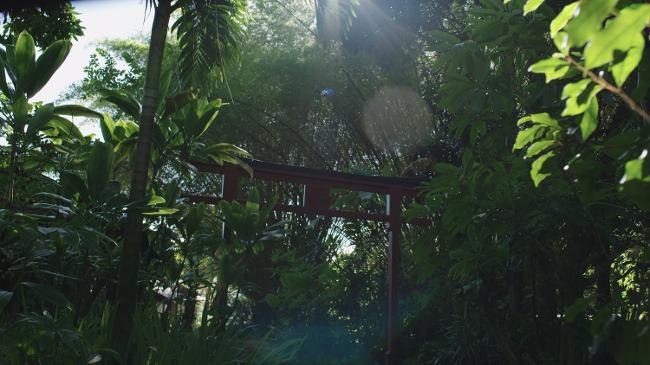
An exquisite montage of neon lights surprises us as the slow notes of a piano lead us into a grand theater where we find Alex sitting in the distance, in a far corner of the stage, alone, playing a free-jazz piano solo. We never get closer—to the human figure, that is, even if he appears to be our protagonist—yet the music itself takes us directly to him as its reverberations fill the hall and the film. This is Alex in his element, his “essence.” His solitary musical performance carries us right through the next extended shot in his room where he reads from a book, Dongshan Liangjie’s “Song of the Precious Mirror Samadhi”:
...Penetrate the source and travel the pathways,
embrace integration and treasure the roads.
Affirm this intersection,
do not neglect it.
Natural and wondrous,
it is not a matter of delusion or enlightenment.
Within causes and conditions, time and season,
it is serene and illuminating.
So minute it enters where there is no gap,
so vast it transcends dimension.
A hairsbreadth deviation
and you are out of tune...
We have already experienced a sense of mystical movement in the film: a single leaf of luxuriant greenery blows right and left in the breeze surrounded by others that barely flutter. A cat creeps along in slow motion before lying asleep on the ground mid-day. A chameleon climbs a house plant. These might not feel strange if it weren’t for the fact that the camera rarely follows a person, even when that character would seem to motivate the action. And again, maybe that’s the point: the film is not about action. Characters speak to each other through a whole shot or sequence with their backs to us—no shot/reverse-shot, no over-the-shoulder shot, no establishing shot moving in to a medium shot or close-up. We are “drinking in” a place, and what happens there will happen. From a distance, we see Alex doing apnea exercises in a lake. He lasts underwater for 60 seconds; his trainer, for 90 seconds. We, too, hold our breath, waiting for them to surface. In the rain under a turquoise sky beside a stone shrine at Akiko’s, her voice-over calls us to her chant in behalf of Alex:
“Ke Akua, Great Almighty Creator, great ancestors of Alex, may he open himself to mysteries which are totally incomprehensible and yet have power, meaning, and the meaning becomes ever so deep as we breathe more deeply and we swim in the waters and walk on the mountains and climb amongst the trees... We are together in one breath, in and out, in and out... Mahalo, Ke Akua, for your child who has come home...”
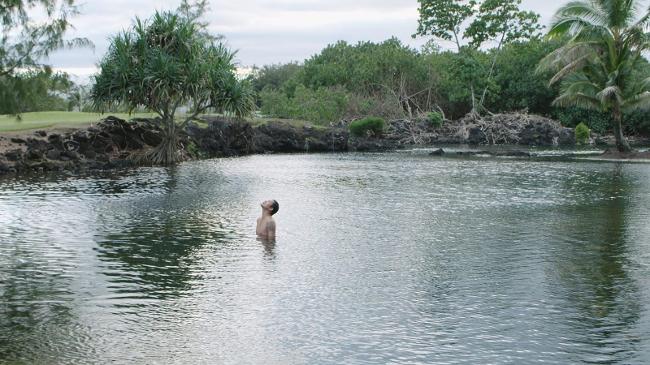
In a static shot from a fixed position—as many are in this film—a peculiar movement is noticeable as one stone among many flips itself up, rolling over and over, inching itself out of the bottom left of the frame. In Alex’s trek through the forest (his back to us), the same percussive sound bank that has led him on his “path” takes him into a dark stand of trees and vines revealing a glimpse of a woman’s bare legs and feet as she exits the frame in the same corner as the stone did. We return to Alex, his eyes closed, and to daylight. The percussion never leaves us, but from inside a dark cave in the woods, the off-screen sax joins the ambient sound by way of a very slow dissolve to Alex, with his back to us still, performing alone on stage in the Palace Theater. Sharing his point of view, we are on-stage with him. In the expansive dark cavern of the auditorium, only one man and one woman are present, seated next to each other, listening attentively.
Has Akiko elicited a transformative experience in Alex? Certainly a soulful visit to the vast lava bed of Hawaii’s volcano touches his emotions and fills him with awe. He and she sit shoulder-to-shoulder with their backs to us. “When was the last time you experienced a place so still?” Akiko asks. And yet, she says, ‘it’s thousands and thousands and thousands of years old,” but the volcano is still bubbling. Again, in August at Akiko’s, silence “speaks.”
If you are not trapped
in being or nonbeing,
who can dare to join you?
Everyone wants to leave
the ordinary current,
but in the final analysis
you come back
and sit in the ashes.
from Dongshan Liangjie,
“The Five Ranks”
Writer-director-editor Christopher Makoto Yogi’s film might look like a narrative if we imagine a series of note cards pasted on his wall, but these have most likely ended up as “way-stations” along a river of reverie, its pace and rhythm enabling clouds of contemplation. The distance the camera creates from a naturally saturated yet often static mise en scène actually generates its own kind of movement, but a different kind—one of the mind. In this dynamic way, both time and space expand and contract in an epic of immediate presence. A singular tactile image can open the frame beyond, to a bigger truth, unseen but transparently available. Suspended time enhances the capacity to observe and to listen to the most minute details of everyday life. Out-of-body experiences that are at once real and virtual are generated via the screen. Beyond language and ideas there is mystery—in direct visceral feelings through the senses.
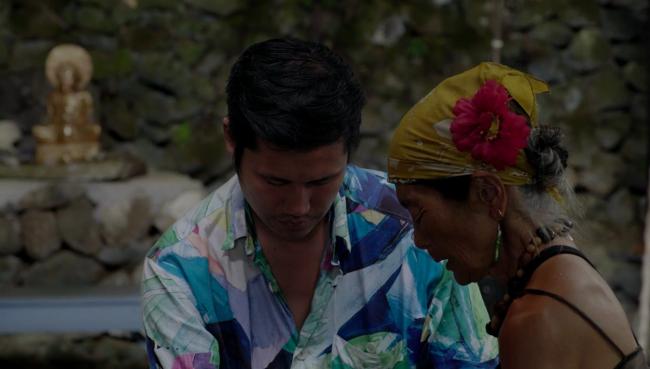
Wailea Village and Hakalau, its neighbor, both grew up as sugar towns after, for example, Tatsuji Kawachi, a businessman from Japan, set up the Wailea Milling Company just over a century ago. Kayo Hatta’s splendid 1995 film, Picture Bride, in which a “city girl” from Japan suffers a mail-order arranged marriage with a field hand on a Hawaiian sugar cane plantation, could be the story of Akiko’s grandmother, given that the bride arrived in 1918. But that was in Honolulu. It’s where Christopher Makoto Yogi was born and raised and where he and Alex Zhang Hungtai (Alex in the film, playing a fictionalized version of himself) went to middle school and high school; Akiko Masuda started out there as a dancer and dance instructor.
Makoto Yogi, who earned his MFA in Los Angeles at USC’s School of Cinematic Arts, has since traced his ancestors exactly to Wailea, whereas Zhang, who delivers a compelling acting debut for the big screen in August at Akiko’s, is actually Taiwanese Canadian, having lived in Taipei, Montreal, Berlin, and many places in the world where he has toured as the acclaimed musician Dirty Beaches and most recently, Last Lizard. Beyond performing his own music in the film, he scored the entire soundtrack. Akiko Masuda, who plays herself as a za-zen practitioner since 1980, opened her home and rental properties to the filmmakers, having beecome a pillar of the community in Wailea, with the goal of preserving and renovating historic structures, creating jobs and affordable housing, and sponsoring local events so as to honor the longtime residents, to allow them to live out their lives on their property. Makoto Yogi, Zhang Hungtai, and Akiko Masuda have all endured the historical legacy of displacement and exploitation in Hawaii by plantation owners, traders, diplomats, missionaries, military leaders, and agricultural and real estate developers. How does one see the past as present, transform alienation into connection, show reality as reverie?
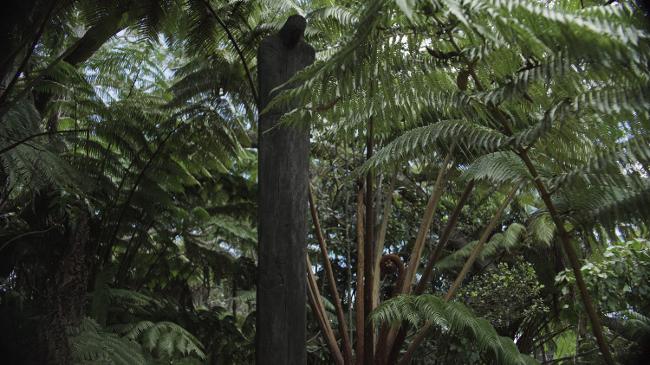
At the Hawaii Film Festival with August at Akiko’s, his feature film debut, Makoto Yogi claimed,
Edison’s camera first arrived in Hawaii in 1898, the same year that Hawaii was illegally annexed by the U. S., and ever since, the moving image and colonization have really gone hand-in-hand. As filmmakers in Hawaii, I feel that we have a deep responsibility to combat this image colonization not only in the stories we tell but also in our cinematic forms and processes. I’m really trying to find a cinematic grammar that is inspired by the land and the complex histories, cultures, and storytelling traditions of the islands.
Hawaii is more than a luxuriant stomping ground of investment, haunted as it may be by those who made it their home; it’s a fragile storehouse of cross-cultural memory—humility, composure, honor, respect, and resilience. As a film, August at Akiko’s is a metaphysical ethnography that actually de-mystifies a place and its people. To do so, the film employs Zen Buddhism not as a religion, a philosophy, an ideology—but as poetry. Likewise, the film shows how both jazz and the haiku, endowed by Zen, allow for a transformative cinematic experience.
August at Akiko’s
Director: Christopher Makoto Yogi; Producer: Sarah S. Kim; Screenplay: Christopher Makoto Yogi; Cinematographer: Eunsoo Cho; Editor: Christopher Makoto Yogi; Sound: Easten Tanimoto; Music: Alex Zhang Hungtai.
Cast: Alex Zhang Hungtai, Akiko Masuda, Kinuko Arakaki, Phoenix Yamashiro, Easten Tanimoto, Steve Iwamoto, Robbie Kane.
Color, 75 min., English
Playing in the American Indie III segment at Filmatique, www.filmatique.com. Also available at Amazon Prime.